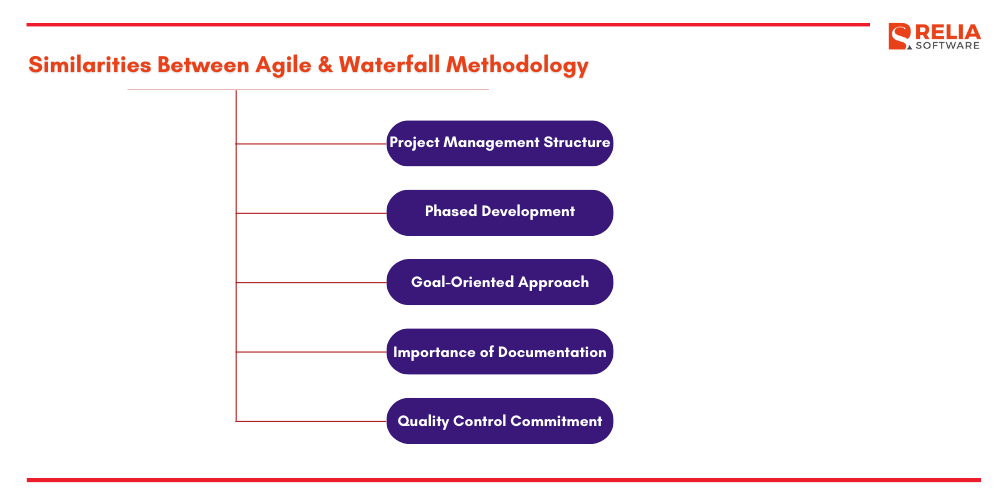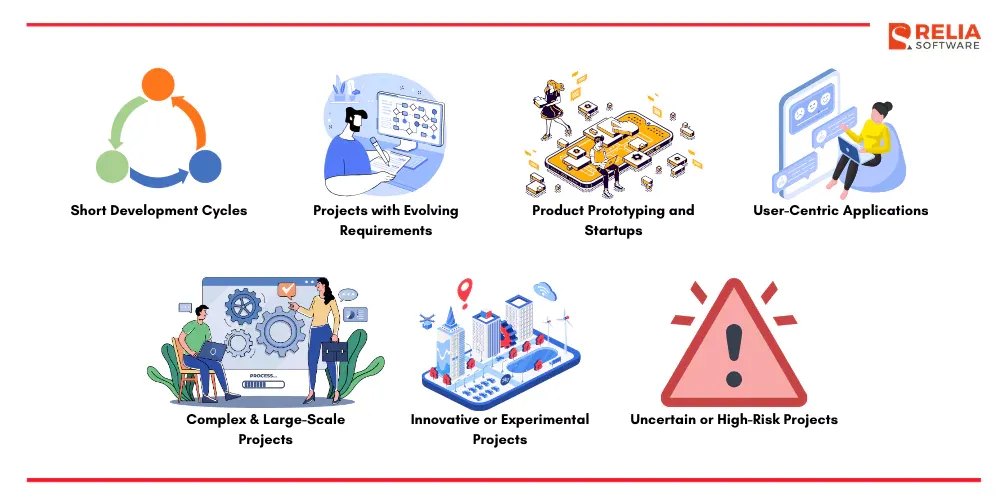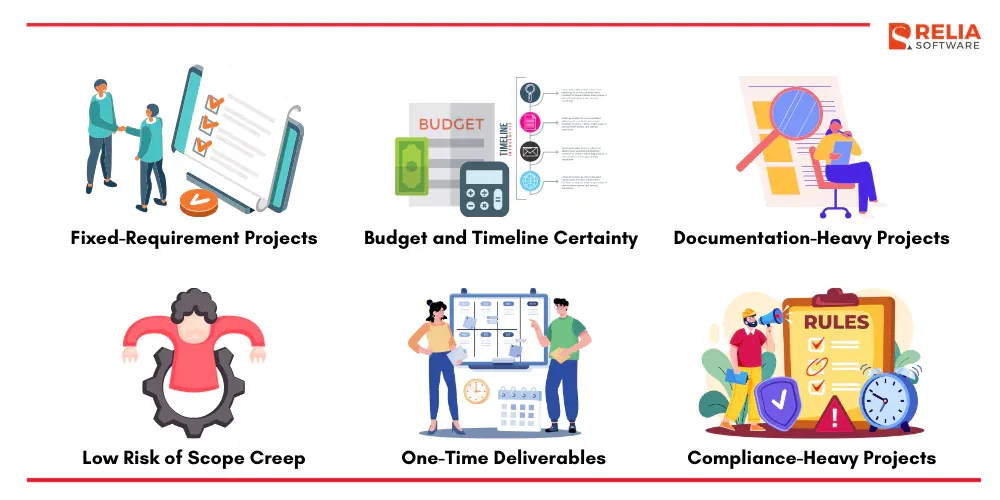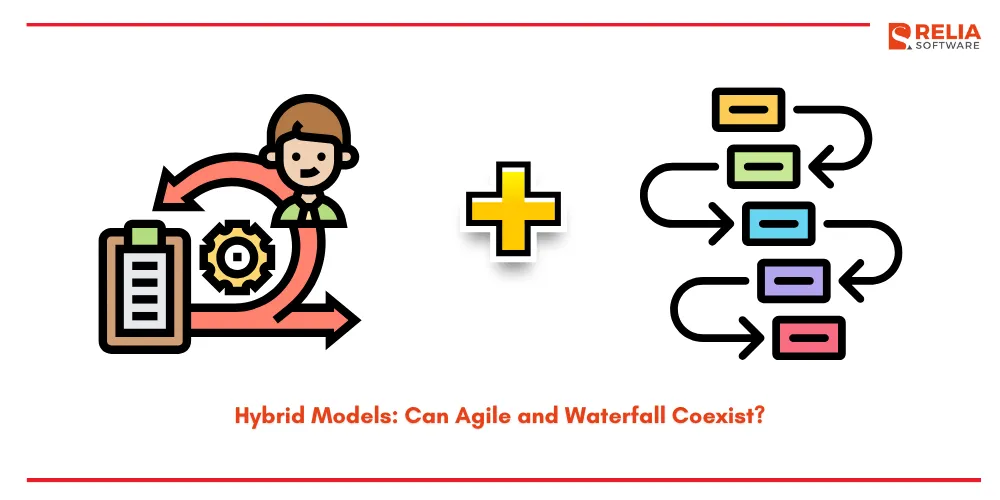Agile and Waterfall are two widely used project management methodologies in software development, each designed to meet different projects and business needs. Agile works well for projects that need flexibility and can change along the way, while Waterfall is ideal for projects that require detailed planning and clear documentation from start to finish.
This article will examine the main similarities and differences between these two methods and show when each works best. You’ll find useful insights and a guide to help match the right approach to your project’s specific needs.
Key Similarities Between Agile and Waterfall Methodology
Agile and Waterfall may have different approaches, but they share some core project management principles that keep projects structured and focused from start to finish.
Project Management Structure
Both methodologies provide a clear path to guide teams through every project stage. They both emphasize:
- Structured Workflows: They use a framework to organize tasks, so everyone knows their steps, roles, and responsibilities.
- Accountability: Roles and responsibilities are well-defined, promoting teamwork and smooth progress.
- Deadlines: Each methodology establishes timelines to keep the project on track, though Agile timelines are flexible while Waterfall timelines are fixed from the start.
Phased Development
Both Agile and Waterfall divide projects into distinct phases to keep them manageable. While the structure of these phases differs, breaking down work into smaller parts helps monitor progress effectively and ensures a clear direction throughout the development lifecycle.
Goal-Oriented Approach
Both methods focus on reaching specific project goals that meet stakeholder needs. This goal-driven approach keeps the team aligned on the project’s ultimate purpose, ensuring the project delivers real value to users or clients.
Importance of Documentation
Documentation is vital in both methodologies, providing continuity and a clear reference for stakeholders and team members. Though each method approaches it differently (extensive upfront in Waterfall or incremental in Agile), documentation both promotes transparency and accountability throughout the project.
Quality Control Commitment
Both methods prioritize quality and testing to ensure the final product meets standards. Testing at various stages helps catch issues early, so the result is reliable and effective.

Key Differences Between Agile vs Waterfall Methodology
Before diving in, have a quick look at the Agile vs Waterfall comparison table below:
|
Factors | ||
|
Approach |
Iterative and incremental |
Linear and sequential |
|
Flexibility |
Highly adaptable to changes |
Fixed scope, minimal flexibility |
|
Timeline |
Flexible, with continuous updates |
Fixed, phase-based timeline |
|
Cost |
Managed and adjusted over time |
Fixed budget set upfront |
|
Stakeholder Involvement |
Continuous feedback and involvement |
Mainly in planning and final review |
|
Documentation |
Minimal, essential documentation |
Extensive upfront documentation |
|
Team Structure |
Cross-functional, collaborative |
Structured by phase, clear roles |
Here’s a closer look at each difference:
Approach to Development
- Agile uses an iterative & incremental approach with short development cycles (sprints) that allow for frequent testing and feedback, enabling teams to adapt to changing requirements quickly.
- Waterfall follows a linear, sequential structure where each phase must be completed before the next begins. This is a more predictable and rigid approach ideal for projects with stable, well-defined needs.
>> Read more:
- 8 Software Development Life Cycle (SDLC) Methodologies
- A Comprehensive Guide to Iterative Development For Developers
Flexibility vs. Predictability
- Agile is highly flexible, enabling adjustment even after the project has started. This helps teams adapt to changing requirements or stakeholder feedback.
- Waterfall prioritizes predictability by defining requirements and scope upfront. This structured approach is great for projects with little chance of change but can struggle if unexpected needs arise.
Project Timeline
- Agile operates on a flexible timeline with continuous releases and updates, well-suited for projects that benefit from early user feedback and refinements.
- Waterfall follows a clear, step-by-step timeline where each phase—design, development, and testing—is completed in order before moving to the next, ending with a single release. This approach provides clarity but less flexibility than Agile.
Cost and Risk Management
- In Agile, costs are managed over time with frequent reassessments through each sprint. It can be more cost-saving for projects needing flexibility, reducing expenses associated with changing requirements.
- In Waterfall, most costs are planned and allocated at the start, making it a good fit for projects with stable, fixed requirements. This upfront budgeting keeps expenses predictable, but it’s less adaptable if changes come up mid-project.
Stakeholder Involvement
- Agile emphasizes continuous stakeholder involvement throughout the project, with regular check-ins, feedback sessions, and adjustments. This ensures the project aligns closely with stakeholder expectations and evolving requirements
- Waterfall involves stakeholders mainly in the initial planning and the final review. This approach works best for projects with stable requirements, as it minimizes changes and keeps the focus on delivering the predefined outcome.
Scope and Documentation
- In Agile, the scope can change based on new insights or feedback, making it ideal for dynamic projects. This flexibility allows Agile to rely on minimal, essential documentation.
- In Waterfall, the scope is set from the start and maintained throughout development, which works well for projects with clear and stable requirements. Waterfall, therefore, relies on detailed documentation at each phase.
Team Structure
- Agile teams are cross-functional and collaborative, allowing team members to take on various roles as needed. This setup encourages quick problem-solving and continuous knowledge-sharing, making it easier to respond to changes effectively.
- Waterfall teams are structured by project phase, with clear roles and centralized leadership. This structure provides order and clear direction, as each team focuses on specific tasks within their phase, but it also limits the adaptability seen in Agile.
Which Cases Should Use Agile Methodology?
Agile methodology is best suited for software development projects that require flexibility. Here are some ideal cases for using Agile:
- Short Development Cycles: Agile’s sprint-based approach is ideal for projects with rapid update cycles, like mobile and web apps, where showing frequent improvements is essential.
- Projects with Evolving Requirements: If project requirements are expected to change based on user feedback or market demands, Agile’s iterative approach allows for adjustments without significant disruption.
- Product Prototyping and Startups: Agile is highly beneficial for startups or prototyping, where frequent testing, feedback, and the ability to pivot are critical. This enables rapid iterations and improvements.
- User-Centric Applications: Applications that rely on user feedback to shape features (mobile apps or digital platforms) benefit from Agile’s frequent releases and feedback loops.
- Complex, Large-Scale Projects: For large projects with multiple components, Agile allows development teams to work in parallel, delivering incremental updates and managing complexity more effectively.
- Innovative or Experimental Projects: If the project involves innovation or exploring new technologies, Agile allows teams to refine their approach as they learn more about the product and users.
- Uncertain or High-Risk Projects: For projects with unknowns or evolving requirements, Agile helps manage risks by testing and adapting frequently. Its iterative structure keeps the project on track, even if goals shift.

>> You may interest:
- What is MVP in Software Development?
- A Deep Dive into Prototype Model in Software Engineering
- 10 Popular Prototyping Tools For UI/UX Developers
- Proof of Concept (PoC) vs Prototype: What Are The Differences?
- Proof of Concept (POC): A Guide to Validating Your Ideas
Which Cases Should Use Waterfall Methodology?
Waterfall is ideal for software projects with stable requirements, clear timelines, and minimal need for changes. Here are the cases where Waterfall excels:
- Fixed-Requirement Projects: For projects with well-defined, unchanging requirements, such as regulatory software, Waterfall’s linear approach ensures each phase is planned and executed precisely.
- Budget and Timeline Certainty: For projects with strict budgets and deadlines, Waterfall’s upfront planning provides a clear cost structure and predictable timeline. This helps avoid unexpected expenses and delays.
- Documentation-Heavy Projects: In fields like finance or healthcare, where thorough documentation is key, Waterfall’s phase-based approach ensures all details are recorded upfront, providing a reliable reference for the entire project.
- Low Risk of Scope Creep: Waterfall’s fixed scope from the start helps control project direction, making it ideal for projects where minimizing changes is important.
- One-Time Deliverables: Waterfall works well for projects designed to produce a single, final deliverable, such as custom enterprise solutions or internal systems that aren’t expected to need continuous updates.
- Compliance-Heavy Projects: Waterfall’s structured process and extensive documentation meet the strict requirements of government and regulated industries, ensuring compliance with standards.

How To Choose The Right Methodology For Your Project?
Choosing between Agile and Waterfall methodologies requires a careful look at your project’s needs, goals, and constraints. Here’s a guide to help you determine the best fit:
- Step 1: Assess project requirements. If requirements are likely to change or need ongoing refinement, Agile’s flexibility makes it a strong choice. For projects with clear, fixed requirements, Waterfall allows for thorough upfront planning.
- Step 2: Consider your timeline. If flexibility is possible, Agile’s adaptability is beneficial. For strict, non-negotiable deadlines, Waterfall is a better choice.
- Step 3: Evaluate stakeholder and team involvement. Agile works well for projects requiring frequent feedback and collaboration. In contrast, Waterfall works well when involvement is mainly needed at the planning and review stages.
- Step 4: Factor in budget constraints. Agile suits projects with flexible budgets, allowing adjustments as the project progresses. Meanwhile, Waterfall’s upfront planning enables predictable cost management, minimizing unexpected expenses.
- Step 5: Consider the project type and industry standards. Industries like e-commerce, startups, or social media platform development often benefit from Agile’s adaptability. In contrast, healthcare projects, banking systems, and insurance software development often require Waterfall’s linear approach due to regulatory requirements and extensive documentation needs.
Hybrid Models: Can Agile and Waterfall Coexist?
Yes, Agile and Waterfall can work together effectively in a hybrid approach, where each method’s strengths complement the other’s. In a hybrid model, Waterfall’s structure provides a clear framework for the overall project, while Agile’s flexibility is used in specific phases that benefit from iterative progress.
For instance, planning and design might follow Waterfall to establish a solid foundation and detailed requirements, ensuring all stakeholders are aligned. Then, Agile cycles (sprints) can drive the development and testing phases, allowing teams to incorporate feedback, make adjustments, and release updates as they progress.

>> Read more:
- Top 10 Agile Frameworks In Software Engineering
- How To Reduce Software Development Cost?
- Common Software Development Challenges: How to Tackle Them?
- In-depth Guide To Software Development Pricing Models
- 8 Popular Types of Engagement Models in Software Development
- How To Manage A Software Development Team?
Conclusion
Agile and Waterfall each bring unique strengths to project management, tailored to different types of project needs and structures. Selecting the right approach depends on factors like project scope, team collaboration style, and industry requirements. By understanding their core differences and best use cases, this Agile vs Waterfall comparison helps you align the right methodology with your project goals, leading to greater efficiency, effective cost management, and successful outcomes.
>>> Follow and Contact Relia Software for more information!
- development

